Wiki
Clone wikiProject Team / 210
Project Team version 2.1.x
The content of this page applies to the following version(s) of Project Team:
- v. 2.1.1 for JIRA 5.1 or newer
- v. 2.1.0 for JIRA 5.1 or newer
On this page:
What's new in this version?
- Access to the "Project Team" tab configurable via add-on permissions
A new tab named "Permissions" was added under add-on configuration section. On this tab you can choose which project roles can View the "Project Team" tab.
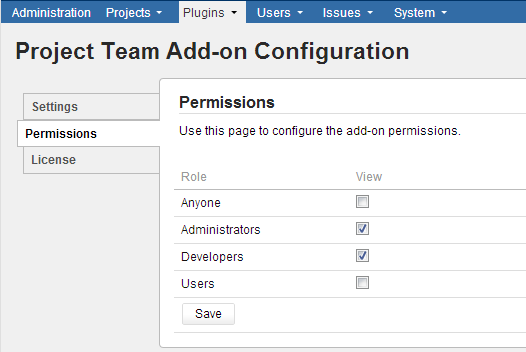
The users who do not have the View permission do not see the "Project Team" tab at all.
If a JIRA user is member of a project role that has View permission permission but he/she is also member of another project role that does not have the View permission, it is considered that the user in question has View permission.
- A setting for enabling/disabling the display of the JIRA Project Admin
You can now choose to display or not the JIRA Project Admin on the top of "Project Team" tab. This is possible due to the new "Display JIRA Admin" checkbox added under the add-on's Settings page.
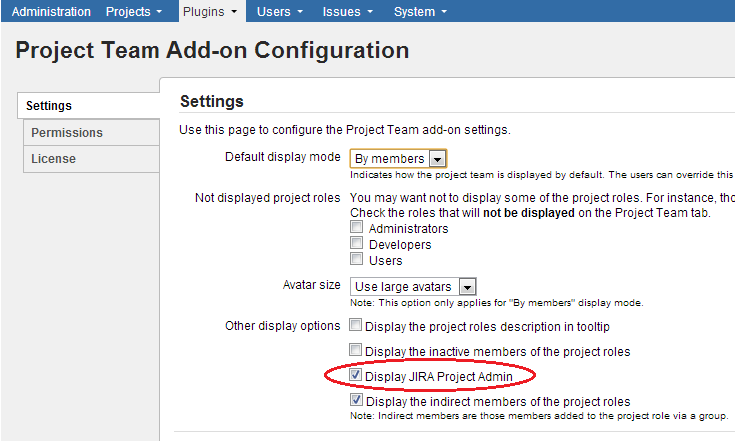
What Project Team does?
The add-on adds a new tab named "Project Team" on which the team members are displayed along with their project roles as they are defined and configured by the JIRA or project admin. The team can be displayed in two different modes, depending on the user's selection.
Project team displayed by members
In this mode each team member is listed along with its full name, username, avatar, email address and project role(s). You can click the username to see the profile of the user.
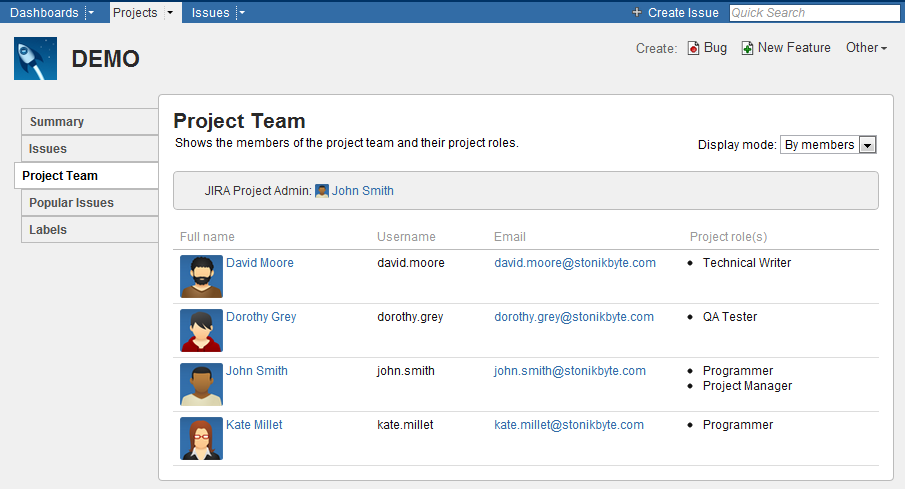
JIRA Project Admin displayed on top of the page represents the JIRA project lead - an user that usually has admin rights on the project and can, for instance, add new components or new versions to the project. The JIRA administrator can choose to display or not the JIRA Project Admin via add-on configuration settings.
This mode is used when Display mode is set to By members. The size of the avatar (small or large) can also be changed in the add-on configuration page (see Configuring the add-on settings).
Project team displayed by project roles
In this mode each role defined in the project is listed along with its members. You can click the username to see the profile of the user.
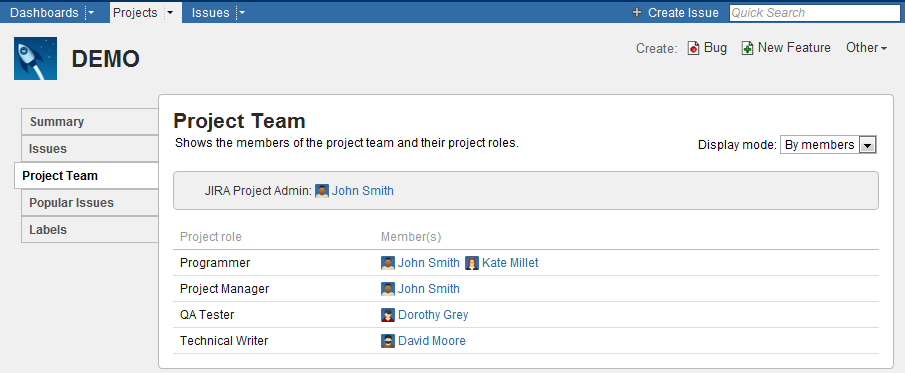
JIRA Project Admin displayed on top of the page represents the JIRA project lead - an user that usually has admin rights on the project and can, for instance, add new components or new versions to the project. The JIRA administrator can choose to display or not the JIRA Project Admin via add-on configuration settings.
This mode is used when Display Mode is set to By roles.
Changing the display mode
The user can change the display mode via the Display mode dropdown list from the top-right corner of the Project Team project tab.
If the user never changed the display mode, the default display mode configured in the Add-on Configuration Settings page is used.
Installing Project Team
Project Team is a deployable add-on, composed of a single JAR file, which can be installed directly from the Universal Plugin Manager (UPM).
But, if you manually downloaded the JAR file by accessing the add-on's Download link from Marketplace, follow the next steps to install it:
- Log on to JIRA as an administrator
- Go to Administration
- Go to Plugins menu and click Plugins to open UPM page
- Go to Install tab
- Click Upload Plugin
- Select the JAR file of Project Team
- Click Upload to start the installation. When the installation is done, a confirmation message is displayed.
The add-on is not fully functional at this time. You must obtain and activate a trial or commercial license in order to use Project Team. See Activating the add-on license.
Activating the add-on license
In order to run the Project Team add-on you need a trial or a commercial license. You can purchase Project Team on the Marketplace or through the Universal Plugin Manager (UPM). Once you obtained a license code you must activate it. License activation steps depend on the version of Universal Plugin Manager (UPM) installed on your JIRA instance.
License activation when UPM is 2.0 or newer
If you have Universal Plugin Manager (UPM) 2.0 or newer, follow the next steps to activate Project Team license:
- Log on to JIRA as an administrator
- Go to Administration
- Go to Plugins menu and click Plugins to open UPM page
- Locate and expand the Project Team add-on under User-installed Plugins
- Enter the license code in the Enter the new license field
- Click Update. If your license is valid, a confirmation message is displayed on top of the page.
License activation for an earlier version than UPM 2.0
If you have a version of Universal Plugin Manager earlier than 2.0, follow the next steps to activate Project Team license:
- Log on to JIRA as an administrator
- Go to Administration
- Go to Plugins menu and click Licensing under Project Team Add-on Configuration
- On the Licensing tab enter the license code in the Enter the new license field
- Click Update. If your license is valid a confirmation message is displayed on top of the page.
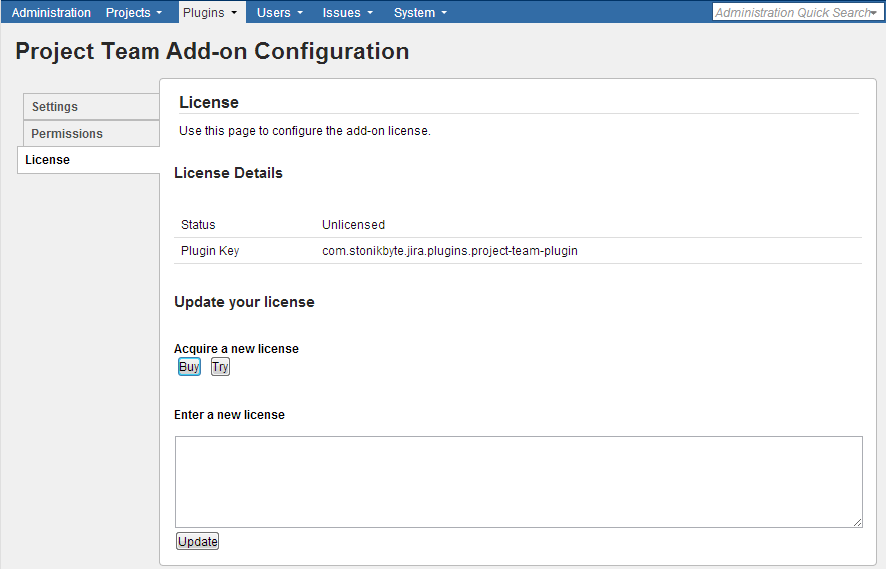
Configuring the add-on settings
To configure the Project Team add-on settings follow the next steps:
- Log on to JIRA as an administrator
- Go to Administration
- Go to Plugins menu and click Settings under Project Team Add-on Configuration
- On the Settings tab, change the settings to suit your preferences. See the table bellow for a complete description of the available settings.
- Click Save to apply the settings
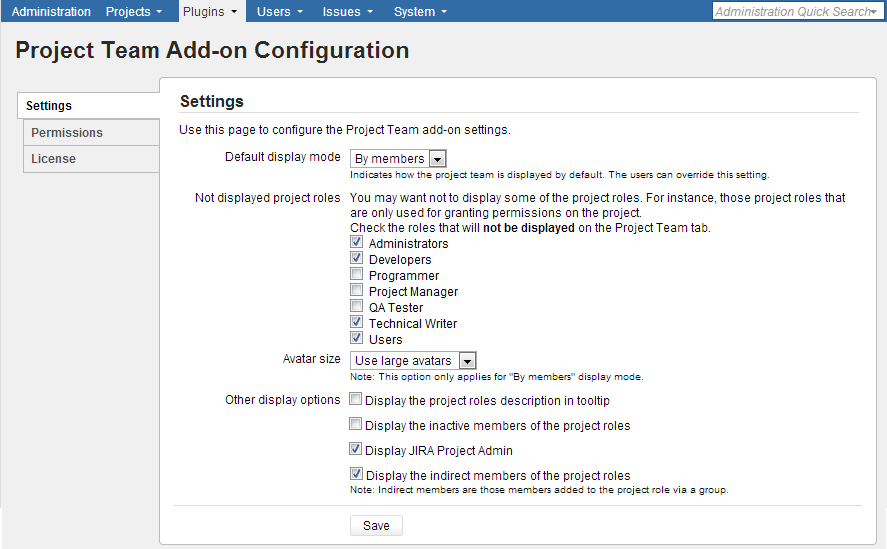
| Item | Description |
|---|---|
| Default display mode | This option indicates how the team is displayed on the Project Team tab if a display mode was not yet selected by the user. There are two options available: By members – displays the members of the team along with their e-mail address and project roles. This is the default option. By roles – displays the roles of the project and their members. |
| Not displayed project roles | You may not want to display some of the project roles. For instance, those project roles that are only used for granting permissions on the project or for notification schemes. Check the roles that you don’t want to be displayed on the Project Team tab. All the project roles defined in JIRA are listed. |
| Avatar size | Choose between using large or small avatars. The default value is Use large avatars. This option only applies when the current display mode is By members. |
| Other display options | Check Display the project roles description in tooltip if you want the description of the project role to be displayed in a tooltip when the user moves the mouse pointer over a project role. This option is by default unchecked. Check Display the inactive members of the project roles if you want the inactive (deactivated) JIRA users that are members of a project role to be shown on the Project Team tab. This option is by default unchecked. Check Display JIRA Project Admin if you want the JIRA Project Admin (project lead) to be displayed on top of the Project Team tab. This option is by default checked. Check Display the indirect members of the project roles if you want the indirect members to be shown on the Project Team tab. Indirect members of a project role are those members that were added to the role via a group. This option is by default checked. |
Configuring the add-on permissions
By default anyone can visualize the "Project Team" tab of a project. You can restrict the access to the "Project Team" tab through add-on permissions configuration. Follow the next steps to configure the add-on permissions:
- Log on to JIRA as an administrator
- Go to Administration
- Go to Plugins menu and click Permissions under Project Team Add-on Configuration
- On the Permissions tab, check the the project roles that are allowed to View the "Project Team" tab.

- Click Save to apply the changes.
NOTE If a JIRA user is member of a project role that has View permission permission but he/she is also member of another project role that does not have the View permission, it is considered that the user in question has View permission.
Updated